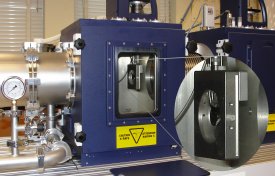Market leaders in temperature controlled microscopy, Linkam Scientific Instruments, have been chosen by the Chemistry Department of the University of Manitoba to characterize liquid crystal composites conjunction with SAXS.
The research goal of Associate Professor Torsten Hegmann's group in Manitoba is the fabrication of liquid crystal (LC) nanocomposites using functionalized metal or semiconductor nanoparticles as dopants in thermotropic amphiphilic and non-amphiphilic nematic, smectic and other types of liquid crystals. Of particular interest is the design of LC nanocomposite materials, chiral and non-chiral, that will respond to external stimuli such as temperature and applied electric fields. LCs are extremely useful in a variety of applications (e.g., flat panel displays, light shutters, spatial light modulators and others), because external perturbations via applied electric fields as well as modified surfaces (e.g. alignment layers) can cause significant changes in the macroscopic properties.
 Linkam HFSX350-GI temperature stage (zoomed inset) mounted vertically in Rigaku SAXS system at the University of Manitoba.
Linkam HFSX350-GI temperature stage (zoomed inset) mounted vertically in Rigaku SAXS system at the University of Manitoba.
To achieve this and to gain a fundamental understanding of the unique interactions between nanomaterials and LCs, Professor Hegmann's lab is developing a systematic approach of functionalising NPs and LCs to fine-tune mutually beneficial interactions. This approach will open up a new area of nanomaterials for developing new or improving existing electro-optical applications of LCs.
One of the most important techniques to characterize LCs is provided with a heating/cooling stage. Having used several other Linkam stages in conjunction with other types of light microscopy, such as polarized and fluorescence confocal, and having published several peer-reviewed papers, Professor Hegmann selected a special Linkam stage for SAXS studies. One has been designed for vertical and another one for horizontal mounting both transmission and grazing incidence experiments, respectively.
The latter enables an x-ray beam to be focused on a droplet of an LC to study aligned LC mono-domains. This is possible as the heating block is flush with the external surface of the stage body thus allowing the horizontal x-ray beam interaction with the sample. There are provisions for using capillary tubes and thin films for liquid sample mounting enabling experiment flexibility. He says "Linkam is the best choice of stage because of its superior temperature control and less bulky control system. I like their open and flexible design which will further enable me to modify these special SAXS stages for advanced experiments involving controlled pressure and vacuum."
The HFSX350-GI stage has a temperature range is -196 to +350 „aC with a pressure range from atmospheric to 10e-3 millibar. Two electrical connectors complete the stage to provide excellent experimental versatility.